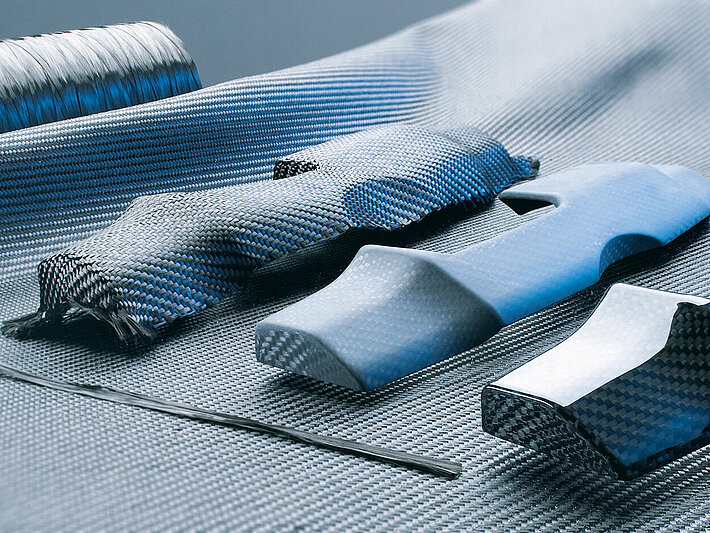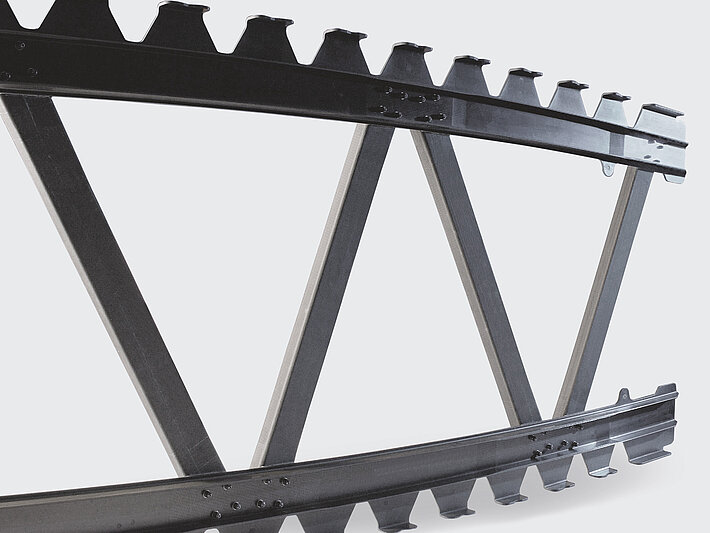What are carbon fibers?
Carbon fibers are industrially produced fibers which are refined in such a way that they consist almost exclusively of carbon. They are microscopically small and about eight times thinner than a human hair.
In order to make them usable for various applications, 1000 to 60000 filaments are combined into a multifilament yarn (roving), which is wound onto a spool.
How are carbon fibers produced?
Carbon fibers are the product of a high-tech manufacturing process. It starts with a starting product such as polyacrylonitrile (PAN). Polyacrylonitrile is a solid in the form of a white powder. It is hard and stiff as well as resistant to chemicals and solvents. In a first process step, thin threads are produced from it, which are then wound onto a spool – the so-called PAN "precursor" has been created.
In the next step, these threads are placed in the oven. First, they are oxidized at 200 to 300 degrees Celsius and then carbonized at 1200 to 1800 degrees Celsius. What remains are threads with a very high carbon content and high strength. After surface treatment and application of a sizing, the carbon fiber is wound up and is ready for use.

What types of carbon fibers exist?
Already during the production of the precursor, the desired properties are given to the later carbon fibers. Carbon fibers differ mainly in the following properties:
- Number of individual fibers or filaments in the roving
- Diameter and shape of the filaments
- Strength and modulus and the resulting elongation
- Surface properties that also determine the later harmony with various plastic systems in composite materials
Depending on the final application, the requirements for the carbon fibers and the component made of carbon fiber-reinforced plastic also change. While modulus is particularly important for one application, modulus under tensile strength may be the main factor for another application.
You can find our carbon fiber portfolio on our material overview page or in our brochure.
What does CFRP mean?
CFRP is the abbreviation for carbon fiber-reinforced plastic. CFRP is a material consisting of several constitutes: a base or carrier substance, also called matrix, and a second reinforcing component, the carbon fiber, which is embedded in the matrix. Usually a synthetic resin is chosen as matrix material. The cured composite has different mechanical properties depending on the type of carbon fibers used, the matrix and the manufacturing process.
How is CFRP produced?
There are various ways of producing CFRP, which offer different advantages in terms of production costs and/or range of properties, depending on the application. At the beginning of the CFRP manufacturing process, however, is always the carbon fiber. It is woven or laid into a carbon fiber textile or even braided or wound using processes known from the textile industry.
We manufacture our CFRP components from prototype to series production. The following production technologies are used:
- Prepreg compressing molding
- Autoclave technology
- Winding methods
- Blowing methods
- RTM process (Resin Transfer Molding)
- Wet pressing
- Braiding
- Tape laying
- Fiber placement
The diagram on the right-hand side illustrates the different ways of manufacturing a CFRP component.

What properties does CFRP have?
CFRP is mostly used where other materials reach the limits of their load-bearing capacity. Above all, its light weight and resistance are of great importance: CFRP is up to five times lighter than steel and has only about 60 percent of the weight of aluminum.
Other properties include high fatigue strength, X-ray transparency and low thermal expansion. The specific properties for an individual component can be specifically influenced, controlled and optimized.
Where is CFRP used?
There are no limits to the possible applications of CFRP. Today, the most common applications for CFRP are in aerospace, automotive and wind energy. In medical technology, robotics, automation technology, measurement technology and optics, as well as in mechanical engineering and in the sports and leisure sector, CFRP can be used in many different ways.
We offer CFRP solutions for almost all areas of application and advise our customers along the entire value chain - from the fiber to the design, prototypes and series production. Get in touch with us!
How much does CFRP cost?
How much CFRP costs cannot be said in general. The prices are very individual and depend on the development, the type, the production and the corresponding number of pieces in which CFRP is produced. If you have a specific requirement or inquiry, please contact us.
What is the difference between CFRP and GFRP?
Carbon fiber-reinforced plastic (CFRP) and glass fiber-reinforced plastic (GFRP) differ primarily in the use of different fibers. As the name suggests, carbon fibers are used for CFRP, whereas glass fibers are used for GFRP. Plastics based on carbon fibers have a significantly higher strength and are also lighter due to their lower density. Glass fibers, on the other hand, are cheaper, which is why they are often used.





